How Neuro Radiology and Endovascular Procedures are Revolutionizing Medical Treatment?
- surgeonslab1
- Aug 16, 2024
- 4 min read

Neuro radiology and endovascular procedures have advanced greatly in the past decade. These changes have transformed medical treatments. Stroke treatments and aneurysm repairs are evolving rapidly. New imaging tools, along with less invasive methods, are transforming neurological care. These advancements improve accuracy, speed up processes, and lead to better results.
Medical professionals now wield powerful new weapons against complex brain disorders, transforming patient care and prognosis. Let's uncover the key aspects of endovascular and interventional radiology that deserve a closer examination.
Stroke Management
Strokes are a major global threat, striking suddenly and disrupting lives. However, hope is on the horizon. Advanced imaging and new treatments are paving the way for recovery. Those affected by strokes now see a glimmer of hope. Science is armed with effective tools to fight this challenge. Families, once feeling powerless, now have reasons to be cautiously optimistic. The fight against strokes continues, driven by medical innovation.
Doctors now save thousands by removing deadly brain clots. Quick scans identify healthy tissue, broadening treatment options. Perfusion imaging spots salvageable areas, extending care time. This tool helps doctors make quick, informed decisions in emergencies. Personalized care and precise treatments have transformed brain clot care, marking a major leap in medicine.
Neuroradiology's advances have revolutionized stroke care. They allow for quick action and improved outcomes, giving more patients access to vital treatments. Now, recovery prospects are better than ever, marking a significant shift in the field. These developments are crucial, impacting lives and changing medical practices.
Brain Aneurysms & AVMs
Brain aneurysms and arteriovenous malformations (AVMs) are serious threats if untreated. They can lead to severe consequences. Interventional neuroradiologists have advanced surgeon tools to tackle these issues. For instance, flow diverters can redirect blood away from an aneurysm's weak walls. This action helps the body heal and rebuilds the blood vessels.
Liquid embolic agents can block blood vessels causing bleeding in arteriovenous malformations. When used with advanced imaging, these methods achieve high success rates and protect nearby tissues. Research shows early treatment cuts the risk of rupture and brain damage. Using these techniques, interventional neuroradiologists greatly enhance patient outcomes, often with minimally invasive procedures once thought impossible.
Functional Neurosurgery
Technological leaps have revolutionized neurosurgery. Deep brain stimulation now offers hope for Parkinson's, epilepsy, and OCD sufferers. By precisely placing electrodes, neurologists can tame erratic brain activity. This groundbreaking technique restores balance, allowing patients to reclaim their lives. Such innovations mark a new era in treating complex neurological disorders.
Take Parkinson's disease patients, for example. Before Deep Brain Stimulation (DBS), they had uncontrollable tremors and rigidity. After DBS, their symptoms improved significantly. They regained motor control and bettered their quality of life.
Responsive neurostimulation adjusts brain rhythms for better health. This advanced technology harmonizes neural activity, boosting relief and well-being. Neurosurgeons customize treatments for each patient. They push limits, offering new hope to those with complex neurological disorders and fostering brain healing.
Neuro Radiology: Breakthroughs and Innovations
Neuro radiology is crucial for understanding and treating neurological disorders. It aids in early detection and targeted therapy. Recent studies have significantly advanced the field.
Real-time MRI neurofeedback: Researchers discovered that fMRI combined with neurofeedback helps stroke survivors regain motor function. In guided sessions, participants learn to control certain brain activations. This leads to improvements in daily activities.
I-assisted diagnosis: Machine learning can analyze PET scans to detect Alzheimer's stages. This speeds up diagnoses and allows for earlier treatment. The findings highlight neuro radiology's future impact on diagnosis and treatment.
Endovascular Procedures: Transforming Patient Care
Endovascular procedures have greatly improved the treatment of heart disease and cancer. We explore some noteworthy achievements below:
Transcarotid Artery Revascularization (TCAR): TCAR is widely accepted for its lower risk compared to other carotid treatments. Research shows it cuts down major events and strokes.
Mechanical Thrombectomy: Better thrombectomy devices can now remove clots in acute strokes. This has lowered disability rates in those treated.
Advances in Simulation Training and Surgeon Tools
Advancements in neuro radiology and endovascular procedures demand strict training and updates. Traditional methods can't keep up with technology. So, educators must adopt modern simulation tools to prepare surgeons. Surgeon's Lab is an example, offering immersive and interactive learning.
Surgeon's Lab stands out in surgical education. It uses artificial intelligence, machine learning, and haptic feedback for realistic simulations. These cover interventional radiology, including endovascular procedures. Trainers and learners can practice techniques, handle instruments, and understand complications in safe, controlled settings.
Surgeon's Lab provides a wide range of case scenarios for different learning goals. Educators can create personalized courses by choosing specific cases. This makes the platform ideal for structured teaching. Meanwhile, independent learners can study materials that match their interests and goals.
Ending Remarks
Neuro radiology and endovascular procedures are crucial in modern medicine. Technology has boosted their capabilities, raised patient expectations, and increased demand. Despite challenges, optimism remains. This is due to a strong commitment to excellence. The hope is for future innovations paired with simulation training database queries, leading to better health and longer lives.







